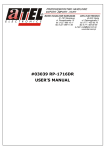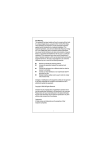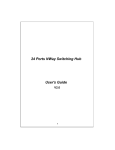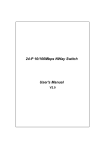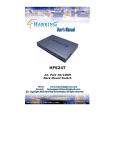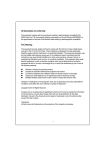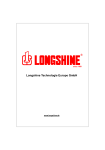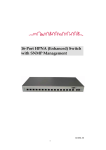Download ENCORE ENH905-NWY network switch
Transcript
CE Declaration of conformity This equipment complies with the requirements relating to electromagnetic compatibility, EN 55022 class A for ITE, the essential protection requirements of Council Directive 89/336/EEC on the approximation of the laws of the Member States relating to electromagnetic compatibility. FCC Warning This equipment has been tested and found to comply with the limits for a Class A digital device, pursuant to Part 15 of the FCC Rules. These limitations are designed to provide reasonable protection against harmful interference in a residential installation. This equipment generates, uses and can radiate radio frequency energy and, if no installed and used in accordance with the instructions, may cause harmful interference to radio communications. However, there is no guarantee that interference will not occur in a particular installation. If this equipment does cause harmful interference to radio or television reception, which can be determined by turning the equipment off and on, the user is encouraged to try to correct the interference by one or more of the following measures: Reorient or relocate the receiving antenna. Increase the separation between the equipment and receiver. Connect the equipment into a different outlet from that the receiver is connected. Consult your local distributors or an experienced radio/TV technician for help. Shielded interface cables must be used in order to comply with emission limits. Changes or modifications to the equipment, which are not approved by the party responsible for compliance, could affect the user’s authority to operate the equipment. Copyright © 2002 All Rights Reserved. Company has an on-going policy of upgrading its products and it may be possible that information in this document is not up-to-date. Please check with your local distributors for the latest information. No part of this document can be copied or reproduced in any form without written consent from the company. Trademarks: All trade names and trademarks are the properties of their respective companies. Table of Contents 1. Unpacking Information 2. Introduction To NWay Switch 2.1 2.2 2.3 2.3.1 2.3.1.1 2.3.1.2 2.3.1.3 2.3.1.4 2.4 2.4.1 3. Installing And Using NWay Switch 3.1 3.1.1 3.1.2 3.1.2.1 3.1.2.2 4. Installing The NWay Switch Desktop Installation Installing Network Cables Station Connection with Twisted-Pair Cable Switch to Switch Connections with Twisted-Pair Cable Switching Operation 4.1 4.2 4.3 5. General Description Key Features The Front Panel LEDs Power LED 100M LED Link/Act LED FDX/COL LED The Rear Panel Power Connecting MAC Address Table & Learning Filtering and Forwarding Store and Forward Product Specifications 1 1. Unpacking Information Thank you for purchasing the NWay switch. Before you start, please check all the contents of this package. The product package should include the following: 1. 2. 3. 4. One NWay switch One external power adapter Screws and wall-mount plastic User’s manual 2 2. Introduction To NWay Switch 2.1 General Description The device is a powerful, high-performance Fast Ethernet switch, with all ports capable of 10 or 100Mbps auto-negotiation operation (NWay) which means the switch could automatically negotiate with the connected partners on the network speed and duplex mode. It is ideal for micro-segmenting large networks into smaller, connected subnets for improved performance, enabling the bandwidth demanding multimedia and imaging applications. Moreover, the 10/100Mbps auto-sensing ability provides an easy way to migrate 10Mbps to 100Mbps network with no pain. Compared to the shared 10Mbps or 100Mbps networks, the switch delivers a dedicated 10/100Mbps connection to every attached client with no bandwidth congestion issue. This switch also supports auto MDI / MDI-X function. Each port could be used to connect to another switch or hub with no crossover RJ-45 cable. Store-and-forward switching mode promises the low latency plus eliminates all the network errors, including runt and CRC error packets. To work under full-duplex mode, transmission and reception of the frames can occur simultaneously without causing collisions as well as double the network bandwidth. The switch is plug-n-play without any software to configure and also fully compliant with all kinds of network protocols. Moreover, the rich diagnostic LEDs on the front-panel can provide the operating status of individual port and whole system. 3 For network connection: The switch can use the following types of cabling: 10BASE-T Category 3, 4 or 5 UTP/STP 100BASE-TX Category 5 UTP/STP Category 5 cable is preferred to use with this product in structured wiring environments. This will ensure correct operation of all ports at 10Mbps or 100Mbps. 2.2 Key Features The switch provides the following key features: Complies with 10BASE-T specifications of the IEEE802.3 standard Complies with 100BASE-TX specifications of the IEEE802.3u standard All RJ-45 ports for 100BASE-TX and 10BASE-T connectivity Supports NWay protocol for speed (10/100Mbps) and duplex mode (Half/Full) auto-detection Supports MDI/MDI-X auto crossover Supports full and half duplex operation on all ports Supports back-pressure (half duplex) and flow control (IEEE 802.3x) Wire-speed packet filtering and forwarding rate Store-and-forward architecture filters fragment & CRC error packets Supports 2K MAC address entries in whole system 128KB buffer memory Supports extensive LED indicators for network diagnostics External power adapter FCC Class A, CE 4 2.3 The Front Panel The front panel of the switch is shown below. The auto-negotiation feature of the switch allows each port of the device running at one of the following four operation modes: Speed 100 Mbps 10 Mbps Duplex Mode Half-duplex Full-duplex Half-duplex Full-duplex Each 10/100Mbps port supports auto MDI / MDI-X capability that is the port could connect either the PC or hub without any cable adjustment. 5 2.3.1 LEDs 2.3.1.1 Power LED This indicator lights green when the switch is receiving power; otherwise, it is off. 2.3.1.2 100M LED The 100M LED indicates the link speed of each port. If the LED lights green, the connection speed is 100Mbps, off for 10Mbps. 2.3.1.3 Link/Act LED Every port has a Link/Activity LED. Steady green (link state) indicates that the port has good linkage to its associated devices. Flashing green indicates that the port is receiving or transmitting data between its associated devices. If the port is connected but the Link/Activity LED is dark, check the following items: 1. The switch and the connected device’s powers are on or not 2. The cable is firmly seated in its connectors in the switch and in the associated device. 3. The connecting cable is good and with correct type 4. The connecting device, including any network adapter is functioning. From the 100M and Link/Activity LED, we could judge the connection speed as following: 100M LED Off Off Green Link/Activity LED Off Green Green Status No Connection Connect as 10Mbps Connect as 100Mbps 6 2.3.1.4 FDX/COL LED A collision occurs when two stations within a collision domain attempt to transmit data at the same time. Intermittent flashing amber of the LED is normal; the contending adapters resolve each collision by means of a wait-then-retransmit algorithm. Frequency of collisions is a message of heavy traffic on the network. If the FDX/COL lights amber which means the port is under full-duplex operation or dark for half-duplex mode. The following table is a summary of LEDs. LED Power Status Steady Green Off 100M Steady Green Off Link/Act Steady Green Blinking Green Off FDX/COL Steady Amber Blinking Amber Off Operation Power is on Power is off Connected as 100Mbps Connected as 10Mbps The port is connected The port is transmitting/receiving data. No connection Full-duplex mode Collision Half-duplex mode 7 2.4 The Rear Panel The rear panel of the switch is shown as below 2.4.1 Power Connecting Plug the circle end of the power adapter firmly into the rear panel of the switch, and the other end into an electric service outlet then the system is ready. 8 3. Installing And Using NWay Switch 3.1 Installing The NWay Switch The switch does not require software configuration. Users can immediately use any of the features of this product simply by attaching the cables and turning the power on. 3.1.1 Desktop Installation To locate the switch on the desktop, place the switch on a clean, flat desk or table close to a power outlet. Plug in all network connections and the power cord, then the system is ready. When deciding where to put the switch then you must ensure: It is accessible and cables can be connected easily Cabling is away from: *Sources of electrical noise such as radios, transmitters and broadband amplifiers *Power lines and fluorescent lighting fixtures. Water or moisture can not enter the unit Air flow around the unit and through the vents in the side of the case is not restricted (company recommend that you provide a minimum of 25mm clearance) To prolong the operational life of your units: Never stack units more than eight high if freestanding. Do not place objects on top of any unit or stack Do not obstruct any vents at the sides of the case 9 3.1.2 Installing Network Cables After placing the switch on the desktop, then we need to know how to connect the device to network. 3.1.2.1 Station Connections with Twisted-Pair Cable Connect each station to the switch by a twisted-pair straight cable (10BASE-T or 100BASE-T cables). Plug one RJ-45 connector into a rear-panel port of the switch, and plug the other RJ-45 connector into the station’s network adapter. 3.1.2.2 Switch to Switch Connections with Twisted-Pair Cable In making a switch to switch connection, you could use any port to connect another switch with straight or cross-over cable. As all the ports support auto MDI / MDI-X function, so the connection is independent of cable type and using a straight cable to make a switch to switch connection is allowed. 10 4. 4.1 Switch Operation MAC Address Table and Learning The switch is implemented with a MAC address table where is composed of many entries. Each entry is used to store the address information of network nodes on the network, including MAC address, port ID, etc. The information is the most important base to do packet filtering and forwarding. When one packet comes in from any port, the switch will learn the source address, port ID, and the other related information in address table. Therefore, the content of the MAC table will update dynamically. 4.2 Filtering and Forwarding When one packet comes in from any port of the switch, it will check the destination address besides the source address learning. The switch will look up the address table for the destination address. If not found, this packet will be forwarded to all the other ports except the port where this packet comes in. If found, and the destination address is located at different port from this packet comes in, the packet will be forwarded to the port where this destination address is located according to the information of address table. But, if the destination address is located at the same port as this packet comes in then this packet will be filtered. 4.3 Store and Forward Store-and-forward is one kind of packet-forwarding methodology. As a store-and-forward switch, it will store the complete packet in the internal buffer and do the complete error checking before transmitting to the network. Therefore, no error packets will disturb the network. It is the best choice when a network needs efficiency and stability. 11 5. Product Specifications Standard Interface Cable Connections Network Data Rate Transmission Mode LED indications System Buffer Memory MAC Address Table Filtering/Forwarding Rate Emission Operating Temperature Operating Humidity Power Type IEEE802.3, 10BASE-T IEEE802.3u, 100BASE-TX IEEE802.3x, Full duplex operation and Flow control 5 * RJ-45 NWay switching ports RJ-45 (10BASE-T) : UTP Category 3,4,5 RJ-45 (100BASE-TX) : UTP Category 5 Auto-negotiation (10Mbps,100Mbps) Auto-negotiation (Full-duplex, Half-duplex) Power 100M Link/Activity FDX/COL 128k bytes 2K 10Mbps: 14,880pps/14,880pps 100Mbps: 148,800pps/148,800pps FCC Class A, CE 00 ~ 500C (32 ~ 1220F) 10% - 90% External switching power adapter (5V) 12













